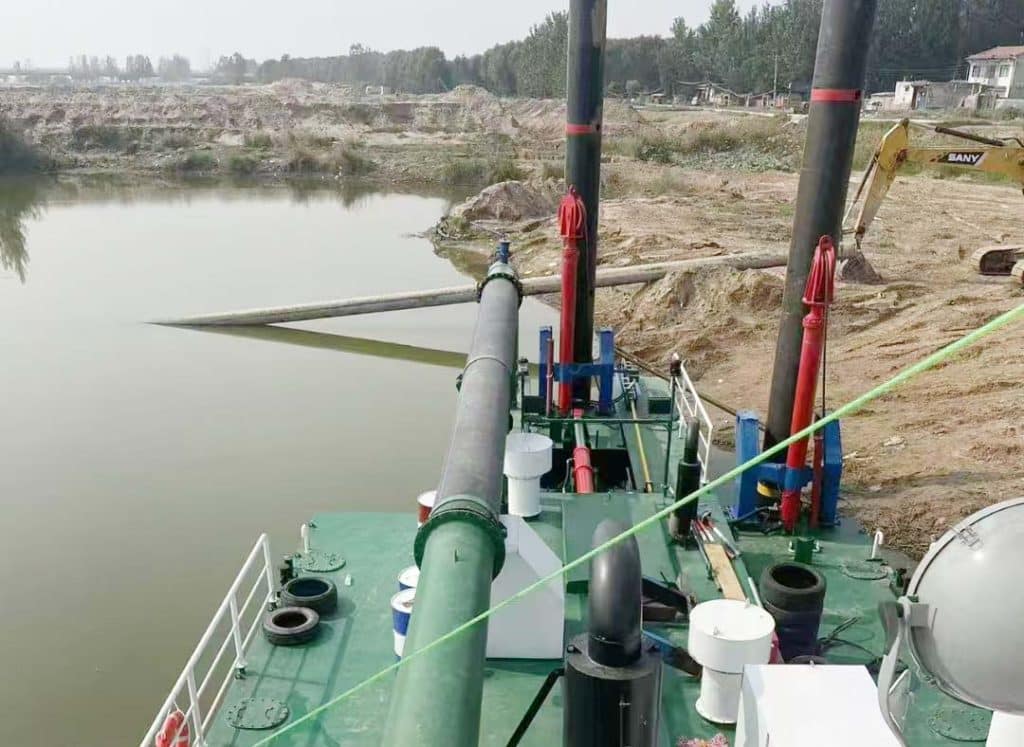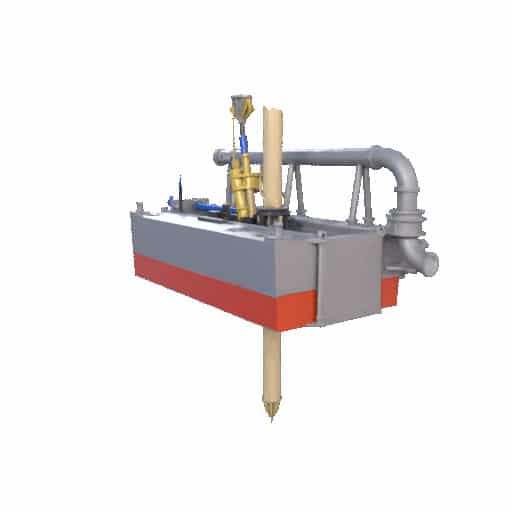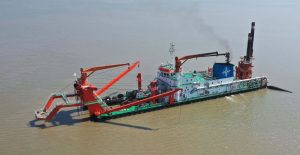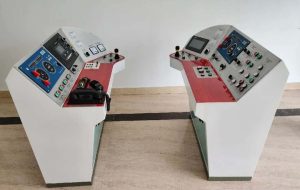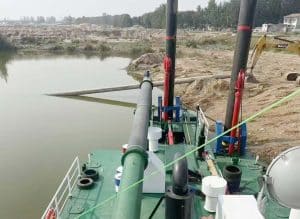🚀 Key Performance Benefits at a Glance
| Performance Metric | Improvement | Technical Specification |
|---|---|---|
| Productivity Boost | 10-20% increase | Reduced repositioning downtime |
| Swing Width (CSD350) | 27 meters | Enhanced dredging coverage |
| Swing Width (CSD600) | 52 meters | Maximum operational efficiency |
| Hydraulic Force Capacity | 1470 kN lifting | Superior handling capability |
Dredging operations demand precision, efficiency, and reliability. However, traditional cutter suction dredgers often face significant downtime during repositioning phases. This challenge costs operators valuable time and reduces overall project productivity.
Fortunately, spud carriers have revolutionized modern dredging operations. These innovative systems boost productivity by 10-20% while maintaining continuous cutting operations. Moreover, they enable precise positioning control that traditional fixed-spud systems simply cannot match.
What is a Cutter Suction Dredger Spud Carrier?
A cutter suction dredger spud carrier is an automated positioning system that moves the dredger forward along its spud without interrupting cutting operations. Think of it as a sophisticated hydraulic platform that eliminates manual spud handling.
Traditional dredging requires operators to manually lift, reposition, and lower spuds after each swing cycle. This process creates substantial downtime and reduces operational efficiency. In contrast, spud carriers automate this entire sequence through hydraulic power systems.
“Spud carriers transform dredging from a stop-and-go operation into a continuous, flowing process that maximizes every minute of operational time.”
The system works by gripping the spud firmly with hydraulic clamps. Then, powerful cylinders push the entire dredger forward while maintaining precise control over cutting depth and swing patterns. This innovation has become essential for modern dredging projects worldwide.
Spud carrier hydraulic system in operation during continuous dredging
How Spud Carriers Boost Dredging Productivity by 10-20%
The productivity gains from spud carriers aren’t just theoretical—they’re measurable and significant. Real-world operations consistently show 10-20% improvements in overall dredging efficiency.
Mechanism: Hydraulic Cylinders and Continuous Operation
Spud carriers use hydraulic double-acting cylinders to push the dredger forward along a fixed spud. These cylinders generate tremendous force—up to 780 kN for travel operations and an impressive 1470 kN for lifting operations.
The system operates through a simple yet effective process:
- Hydraulic clamps secure the spud firmly in position
- Travel cylinders push the dredger forward during cutting operations
- Lifting cylinders raise the auxiliary spud for repositioning
- Control systems coordinate all movements for smooth operation
This mechanism eliminates the traditional cycle of stopping, lifting spuds manually, repositioning, and restarting operations. Instead, the dredger maintains continuous cutting while advancing forward systematically.
Reduction in Repositioning Downtime
Traditional dredging operations lose significant time during repositioning phases. Studies by IADC (International Association of Dredging Companies) show that manual spud handling can consume 15-25% of total operational time.
Spud carriers virtually eliminate this downtime through automated positioning. The system continues cutting operations while simultaneously advancing the dredger position. This breakthrough transforms dredging from an intermittent process into a continuous workflow.
Real Performance Data
Performance improvements vary by dredger size and project conditions. However, typical enhancements include:
- CSD350 Models: Swing width increases to 27 meters with 2000 m³/h production capacity
- CSD600 Models: Swing width expands to 52 meters with 6000 m³/h production capacity
- Operational Depth: CSD350 reaches 9-meter depths while CSD600 achieves 16-meter depths
- Cycle Time: Reduces repositioning time from 15-20 minutes to 2-3 minutes
These improvements directly translate to reduced project timelines and lower operational costs. Additionally, the enhanced efficiency allows operators to complete projects ahead of schedule.
Technical Design and Engineering Features
The engineering behind spud carriers combines robust structural design with sophisticated hydraulic systems. Every component must withstand tremendous forces while maintaining precise operational control.
Four-Layer Platform System Breakdown
Modern spud carriers use a four-layer platform design that distributes loads effectively while providing maintenance access:
- 1st Layer: Supports the walking mechanism and primary load distribution
- 2nd Layer: Houses clamps and lifting cylinders for spud manipulation
- 3rd Layer: Contains spud tilting systems and hydraulic controls
- 4th Layer: Provides maintenance access and secondary systems
This layered approach ensures structural integrity while allowing technicians to access critical components for routine maintenance and repairs.
Hydraulic Spud Clamping and Tilting Systems
The hydraulic spud clamping system uses multiple cylinders to secure spuds during operation. This system prevents spud drop even when cylinder stroke limits are exceeded—a critical safety feature.
Furthermore, the hydraulic spud tilting system offers significant advantages over mechanical alternatives:
- Faster operation compared to manual or mechanical tilting methods
- More reliable performance in harsh marine environments
- Synchronized operation with other hydraulic systems
- Precise control over tilting angles and positioning
Four-layer platform system showing structural design
Hydraulic clamping and tilting system in detail
Structural Specifications and Engineering Standards
Spud carriers must withstand enormous lateral forces during dredging operations. Therefore, manufacturers use rigid steel frames with wear-resistant tracks to handle these stresses effectively.
Key structural features include:
- High-strength steel construction rated for marine environments
- Wear-resistant track systems designed for continuous operation
- Corrosion-resistant coatings for extended service life
- Modular design allowing easy maintenance and component replacement
FEA Validation and Force Calculations
Finite Element Analysis (FEA) validates spud carrier designs under various operational scenarios. This analysis examines stress distribution and deformation patterns during dredging and tilting operations.
Dynamic simulations using ADAMS/LS-DYNA software reveal critical force requirements:
- Travel Forces: Maximum 780 kN for horizontal movement
- Lifting Forces: Maximum 1470 kN for vertical spud manipulation
- Clamping Forces: Sufficient to prevent spud slippage under all conditions
- Safety Factors: Typically 2.5-3.0 times operational loads
These calculations ensure reliable operation even under extreme conditions that exceed normal operational parameters.
Step-by-Step Operational Workflow
Understanding the complete operational workflow helps operators maximize spud carrier efficiency. The process integrates seamlessly with existing cutter head operations while maintaining precise positioning control.
Working Principle of Cutter Suction Dredger Spud Carrier Stimulation Video by IHC
Complete Dredging Cycle with Spud Carrier
The operational sequence follows a systematic pattern that eliminates traditional repositioning delays:
- Initial Setup: Position main spud and auxiliary spud according to dredging plan
- Clamp Engagement: Hydraulic clamps secure the main spud firmly
- Cutting Phase: Cutter head operates while travel cylinders advance dredger position
- Swing Completion: Complete full swing arc while maintaining forward motion
- Auxiliary Positioning: Lower auxiliary spud for next advance sequence
- System Reset: Release main spud, advance to auxiliary position, repeat cycle
This workflow maintains continuous productivity while ensuring precise excavation control throughout the operation.
Auxiliary Spud Usage and Repositioning
The auxiliary spud system enables continuous operation by providing an alternate anchor point during repositioning. When the main spud reaches its forward limit, the auxiliary spud takes over positioning duties.
This handoff process occurs smoothly without interrupting cutting operations. The hydraulic system coordinates both spuds to ensure seamless transitions between positioning cycles.
Coordination with Winch Systems
Spud carriers work alongside sideline wire systems and winches for complete positioning control. These systems coordinate to maintain optimal cutting angles and prevent overcutting in sensitive areas.
The integration between spud carriers and winch systems provides:
- Precise lateral positioning for accurate excavation boundaries
- Coordinated movements that prevent equipment conflicts
- Safety interlocks that prevent dangerous positioning errors
- Automated sequencing that reduces operator workload
Maintenance and Reliability Considerations
Proper maintenance ensures spud carriers deliver consistent performance throughout their service life. The design incorporates maintenance-friendly features that reduce service time and costs.
Integrated Maintenance Manholes
Spud carriers include 600×400 mm maintenance manholes strategically positioned for component access. These manholes eliminate the need to cut additional access points during routine maintenance.
The manholes provide direct access to:
- Roller assemblies for lubrication and inspection
- Hydraulic connections for pressure testing and repairs
- Control systems for troubleshooting and adjustments
- Structural components for wear inspection and replacement
Hydraulic System Maintenance
The performance of spud carriers depends heavily on hydraulic system reliability. Oil leaks can significantly affect spud movements and overall operational efficiency.
Critical maintenance areas include:
- Oil pipe inspections to prevent blockages and ruptures
- Cylinder seal replacement according to manufacturer schedules
- Hydraulic fluid analysis to monitor contamination levels
- Pressure system testing to verify operational parameters
Regular hydraulic maintenance prevents costly failures and ensures consistent operational performance.
Roller Assembly Tolerances and Shaft Immobilization
Precise tolerance matching in roller assemblies ensures smooth operation and extended service life. Typical specifications include:
- Shaft-to-bushing clearance: Approximately 0.60 mm gap for proper lubrication
- Shaft-to-ear clearance: Approximately 0.08 mm for precise alignment
- Roller shaft immobilization: Bolts prevent shaft spinning and frame wear
- Lubrication systems: Automatic systems maintain proper lubrication levels
These precise tolerances require regular monitoring and adjustment to maintain optimal performance standards.
600×400 mm maintenance manhole providing component access
Precision roller assembly showing shaft and bushing tolerances
Applications Across Different Dredging Projects
Spud carriers adapt to various dredging applications, each with unique requirements and operational challenges. The modular design allows customization for specific project needs.
Shallow Water Operations
Many spud carriers are specifically designed for shallow water operations in depths as shallow as 6 meters. These systems require modified designs to accommodate limited water depth while maintaining full operational capability.
Shallow water adaptations include:
- Reduced draft requirements for access to confined waterways
- Modified spud lengths appropriate for shallow depths
- Enhanced maneuverability for tight operational spaces
- Specialized positioning systems for precise shallow water control
These modifications enable effective dredging in rivers, harbors, and coastal areas with depth restrictions.
Offshore and Harsh Environment Customizations
Offshore dredging presents unique challenges that require specialized spud carrier designs. These systems must withstand harsh marine conditions while maintaining reliable operation.
Offshore customizations include:
- Reinforced structural components for wave and weather resistance
- Corrosion-resistant materials for extended saltwater exposure
- Enhanced safety systems for remote operational environments
- Redundant hydraulic systems to prevent operational failures
These enhancements ensure reliable operation in demanding offshore conditions where equipment failure could have serious consequences.
Harbor Maintenance vs. Land Reclamation Requirements
Different project types require specific spud carrier configurations. Harbor maintenance projects typically need precise positioning for navigation channel work, while land reclamation projects prioritize maximum production rates.
Harbor maintenance features:
- Precise depth control for maintaining navigation channels
- Minimal environmental impact systems for sensitive areas
- Quick positioning capabilities for efficient operations
Land reclamation features:
- High production capacity for large-volume material movement
- Extended operational range for covering large areas
- Robust construction for continuous heavy-duty operation
This versatility makes spud carriers suitable for projects ranging from coastal infrastructure development to routine harbor maintenance.
Performance Data: Industrial Specifications
Real-world performance data demonstrates the tangible benefits of spud carrier systems across different dredger configurations. This data helps operators select appropriate equipment for specific project requirements.
🔧 Comprehensive CSD Performance Specifications
| Dredger Model | Max Depth (m) | Production (m³/h) | Swing Width (m) | Cutter Power (kW) |
|---|---|---|---|---|
| CSD350 | 9 | 2,000 | 27 | 350 |
| CSD450 | 12 | 3,500 | 35 | 450 |
| CSD600 | 16 | 6,000 | 52 | 600 |
| CSD800 | 20 | 8,500 | 68 | 800 |
Production Rates and Operational Depths
The production rates shown above represent optimal conditions with spud carrier systems. These figures demonstrate significant improvements over traditional fixed-spud operations.
Factors affecting production rates include:
- Material type and density being dredged
- Pump efficiency and pipeline configuration
- Weather conditions and operational environment
- Operator experience and maintenance quality
The integration of advanced pump systems with spud carriers maximizes these production capabilities.
Modular Design Benefits
Modern spud carriers feature modular designs that offer significant advantages for operators and project managers:
- Easy transportation in standard shipping containers
- Quick assembly and disassembly for project mobility
- Simplified maintenance through component replacement
- Cost-effective upgrades without complete system replacement
This modularity particularly benefits projects requiring equipment transportation between multiple locations.
Frequently Asked Questions
Q1: What is the purpose of a spud carrier on a cutter suction dredger?
A: A spud carrier moves the dredger forward after each swing, reducing downtime and increasing dredging efficiency by up to 20%. It eliminates manual spud handling and enables continuous cutting operations throughout the dredging cycle.
Q2: How does the spud carrier operate hydraulically?
A: It uses powerful double-acting hydraulic cylinders to push the dredger forward while maintaining cutting operations. The system generates up to 1470 kN of lifting force and 780 kN of travel force for reliable operation.
Q3: Can spud carriers be retrofitted to existing dredgers?
A: Yes, spud carrier systems are available for both new builds and existing vessels. The modular design allows integration with most cutter suction dredger configurations with appropriate engineering modifications.
Q4: What are typical dredging depths and production rates for CSDs with spud carriers?
A: For example, the CSD350 can dredge up to 9 m depth with 2000 m³/h production, while the CSD600 reaches 16 m depth and 6000 m³/h production. Performance varies based on material conditions and operational parameters.
Q5: How does the spud carrier affect the swing width of the dredger?
A: It increases the swing width significantly, enabling larger dredging arcs and improved productivity. CSD350 models achieve 27-meter swing widths, while CSD600 models reach 52-meter swing widths with spud carrier systems.
Q6: Are spud carriers suitable for offshore dredging?
A: Yes, specially designed rugged spud carriers are available for offshore and demanding environments. These systems include reinforced structures, corrosion-resistant materials, and enhanced safety features for reliable offshore operation.
Choosing the Right Spud Carrier System
Selecting the appropriate spud carrier system requires careful consideration of project requirements, operational conditions, and budget constraints. The right choice significantly impacts project success and long-term operational efficiency.
Ocean Blue Company’s Customization Approach
Ocean Blue Company brings over 25 years of dredging equipment expertise to spud carrier design and manufacturing. Our approach focuses on understanding specific project requirements and delivering customized solutions that maximize operational efficiency.
Our customization process includes:
- Detailed project analysis to understand specific requirements
- Custom engineering tailored to operational conditions
- Quality manufacturing using proven materials and methods
- Comprehensive testing before delivery and installation
- Ongoing support throughout the equipment lifecycle
This comprehensive approach ensures that every spud carrier system delivers optimal performance for its intended application.

